Consider the loneliness of the CVO Convertible. It is a bike without peer, a cohort of one, an outlier, a motherless child. Consider this: Among its ostensible stablemates in the Custom Vehicle Operations barn, it is the sole non-Touring platform model, and has been for a couple of years, and the only model in the history of the exalted division that was cut from whole cloth, having no foundational model in the core Harley-Davidson Softail collection to serve as a starting point for the CVO’s signature tarting up. And among all Softails it is the sole model equipped with the quick-detach “Convertible” complement of touring accessories, as well as the only model equipped with an electronic throttle, sound system and cruise control. And among all Harley-Davidson models, CVO or otherwise, it is the only machine equipped with a keyless ignition and lockable soft-sided panniers. Oh, and it’s the only bike powered by the counterbalanced TC 110B motor.
More broadly speaking, with the eclipse of the once-vibrant production custom industry in America—a casualty of the recession that’s ravaged the high-end of the motorcycle market since 2007, taking with it the likes of American Ironhorse, Big Dog and Big Bear among many others—the Convertible’s something of a last-man-standing in the big-inch, big-billet, big-chrome, big-tire, sick-paint, $30K sticker price genre.
Take all of that and add to it the fact that only 1,500 CVO Convertibles will be produced for 2012 (down from 2,400 last year), split among three paint and graphic schemes, and you have an unmatched level of exclusivity and a positively heartbreaking degree of loneliness. It’s enough to make a sensitive man weep—or a savvy collector run out and buy one.
The Convertible was first introduced in 2010 and it was a unique stunner right out of the box. It wasn’t just the first convertible model to emerge from Milwaukee in a decade, it was the first time the treatment had been applied to a Softail. In the hands of the CVO designers, though, the convertible concept had changed considerably. Whereas in previous usages, the concept had been one of no-nonsense utility—taking an able if doughty Dyna and giving it some sport-touring pretensions—it became one of creating a hybrid of a show-quality pro-street Softail and a reasonably serviceable long-haul custom bagger. Beautifully and creatively executed, the model became an instant winner in the eyes of most, ourselves included.
There were plenty of laurels to rest on, but the CVO designers were having none of that and when the second iteration of the Convertible appeared in 2011 it had been given a raft of equally unique improvements and innovations. Easily the oddest innovation was the keyless ignition, but the other changes were all about function. Giving the model an electronic throttle that only Touring models had boasted previously not only cleaned up the appearance of the handlebar but also permitted the fitment of a cruise control in addition to the existing ABS. That cruise control was, and remains, unique in that a single control switch module on the hand grip cluster made deployment and adjustment a one-thumb operation. A rudimentary sound system was installed on the fairing, one with 20 watts of power, a pair of speakers aimed at the operator, and an iPod dock. Additionally, the existing saddlebags were replaced with larger units using flip-top lids in place of straps and buckles, and a pair of locks.
Those were the touring amenity upgrades. The model’s underlying custom cruiser elan got some attention as well with the fitment of a new Z-bar handlebar, one that housed internal conduits to keep the internally channeled wiring from crimping at the sharp bends up top. Yet another bold first for the model.
The CVO’s continuing development that resulted in the current Convertible tested here focused on the fairing. Feedback had been elicited by the CVO from existing Convertible owners (something they do a lot for all their models) and topping the list of suggestions/complaints was the fairing. Put succinctly they said: More wind protection, please.
Ask and ye shall receive. Improved wind protection for 2012 is achieved by adding a pair of wind baffles to the fairing’s lower portion, and by scrapping the previous windscreen outright in favor of one that’s two inches wider and an inch taller, and also features a vent cut into it to create some updraft to further calm the air effects on the operator. It’s tinted now, too, which alleviates the previous clear screen’s distracting—and at times, blinding—reflections of the chrome dash.
Addressing another weak point in the Convertible’s touring amenities, the bike’s sound system received a major rethinking as well. The rather primitive iPod dock setup has been replaced by a Garmin GPS/MP3 player, one that’s actually powered by the bike’s electrics to keep things up to snuff all day long. The upshot here is that Convertible buyers no longer get a free iPod with their purchase; they get a free Garmin/MP3 that’s integrated such that directional commands from the GPS override the tunes so you don’t miss a turn while riveted to Pumped Up Kicks.
The drill
There are two ways to view what we have here with the CVO Convertible, depending on how, when, and where you ride. The bike’s either a sweet custom barhopper with a suite of touring accoutrements—saddlebags, fairing, pillion and sissy bar/backrest—in the garage for quick fitment should the lonesome highway call, or it’s a badass bagger that can brave the elements, haul the groceries and a pillion pal and then strip down to its glamorous essentials for boulevard profiling when Main Street is on the itinerary.
Then there’s the third option, and that comes with the simple realization that you can have any number of combinations of the foregoing. After a month with the mount, my default setup became running just the fairing and bags, making for a head-turner of a solo pro-street tourer.
Whichever approach you choose, it can be effected in mere minutes, whether bagging the bike up or stripping it down, and accomplished without any tools. Some adroitness (that comes with minimal practice) is called for to master the drill—that and a can of WD 40 for the grommets on the fairing docks. They’re incredibly snug, as they should be.
The details
As noted, one of the Convertible’s peerless attributes is the keyless ignition. There’s no conventional ignition switch on the bike and the act of turning it on and off is executed by means of the kill switch. So long as the bike’s Smart Security key fob is in near proximity to the machine, flipping the switch to the “Run” position brings the circuitry to life and the “Off” position shuts it all down. If you’re in the habit on any other model of hitting the kill switch before turning off the ignition, and then returning the switch to the “Run” position for later start-up, lose the habit. It’s a gee-whiz bit of tech with no discernible benefit, save that of assuring that you don’t ride off without your fob. You do get an actual key, though. It serves only to lock the fork and saddlebags.
With the fob in pocket, settle yourself down into the saddle of the Convertible. And keep settling. With a seat height of a scant 24.4 inches, it’s a long way down. Once there, the reach to the Z-bar is close but comfortable, as is the reach to the footboards. The absence of a heel-shifter makes for ample space for fidgety feet over the distance. It’s a somewhat compact ergonomic triangle that strikes a good balance for riders of a range of sizes. It works well enough for my long frame, and is especially appreciated by shorter ones, explaining in large part why the Convertible is the most popular CVO model among women riders.
The pull on the hydraulic clutch lever is firmer than on OE cable-actuated clutches and engagement is quick enough to take some getting used to. Better get used to it too, because the TC 110B doesn’t like to be kept waiting. It packs a 105 ft/lb wallop and fairly lunges off the line. It’s also a buzzy mill emitting more vibration than either the TC 96B or TC 103B motors. That vibration is sufficiently tamed for clear-mirror steady-state operation but quick twists of the throttle bring a pronounced shudder when the revs are below about 3000 rpm. As a practical matter, sixth speed is a 75 mph-plus proposition. Below that speed, fifth gear is a more satisfying and responsive selection.
There’s enough low-level vibration going on at cruising speed to knock some of the luster off the Rumble Collection chrome/hard rubber footboards and after a couple hundred miles the effort to keep your boots from subtly creeping backwards on the surface becomes annoying. Soft rubber-soled boots or Chuck Taylors are the way to roll on this machine.
The slammed suspension that gives the Convertible its dashing profile and lowdown seat height has its downside as you’d expect. The ride quality isn’t exactly plush by touring standards, but it’s not exactly harsh either except over really jarring pavement conditions. There you’ll want to rise out of the saddle if you spot a real blip on the radar. Cornering clearance suffers as well with the footboards grounding out regularly on twisty roads, and again that’s to be expected.
The verdict
The touring gear improvements brought to the CVO Convertible over the last two years—and particularly for 2012—have succeeded in elevating the model’s touring capabilities from the aforementioned reasonably serviceable pretensions of the original version to downright effective. The more expansive fairing improves conditions in the cockpit considerably. Whereas the previous fairing did a decent job of keeping the blast off the upper body, the new vented unit provides a good bubble for the head as well, making it comfortable to ride in a half-shell helmet—a helmet which can then fit into one of the spacious saddlebags and be locked up.
The question that continues to loom is when—if ever—the myriad of innovative features possessed solely by the Convertible will find their way to the core OE Softail models. We speculated last year that the electronic throttle and cruise control might well appear on the 2012 models. They didn’t. We’d also figured that the flip-top lockable leather saddlebags would be a natural upgrade on both the Heritage Classic and Road King Classic. Wrong again. There’s always 2013.
The CVO Softail Convertible is available in three color and graphic combinations for 2012: the Crimson Red Sunglow with Scarlet Crystal Graphics shown here, as well as Abyss Blue with Catacomb Graphics and Satin Pewter with Catacomb Graphics. The MSRP is $26,699.



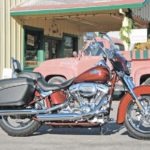

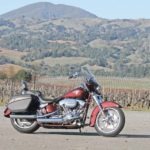

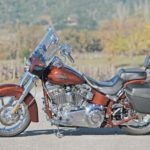



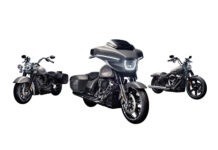



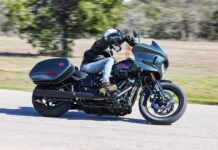










Why did they discontinue the convertible? What does that do to the value of my 2010?